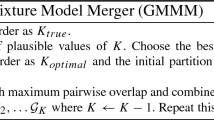Abstract
The resolution of a mixture of two or more populations into its component distributions may be markedly influenced by one or a few atypical values. The maximum likelihood solution effectively assigns (part of) each observation to one or another of the components via the posterior probabilities, even though the observation may be widely discrepant from all components. This paper presents a modification of the mixture problem, in which the typicality of each observation is considered, as well as the posterior probabilities, with the contribution of atypical observations being downweighted. The extension to the multivariate case is discussed.
Similar content being viewed by others
References
Aitchison, J., Habbema, J. D. F., and Kay, J. W., 1977, A critical comparison of two methods of statistical discrimination: Appl. Stat., v. 26, no. 1, p. 15–25.
Campbell, N. A., 1980, Robust procedures in multivariate analysis, I, Robust covariance estimation: Appl. Stat., v. 29, no. 3, p. 231–237.
Clarke, M. R. B., 1971, Updating the sample mean and dispersion matrix: Appl. Stat., v. 20, no. 2, p. 206–209.
Collins, J. R., 1976, Robust estimation of a location parameter in the presence of asymmetry: Ann. Stat., v. 4, no. 1, p. 68–85.
Day, N. E., 1969, Estimating the components of a mixture of normal distributions: Biometrika, v. 56, no. 3, p. 463–474.
Dempster, A. P., Laird, N. M., and Rubin, D. B., 1977, Maximum likelihood from incomplete data via the EM algorithm (with Discussion): Jour. Roy. Stat. Soc. Ser. B., v. 39, no. 1, p. 1–38.
Fowlkes, E. B., 1979, Some methods for studying the mixture of two normal (lognormal) distributions: J. Amer. Stat. Assoc., v. 74, no. 367, p. 561–575.
Hampel, F. R., 1973, Robust estimation: A condensed partial survey: Z. Wahr. verw. Geb., v. 27, p. 87–104.
Hampel, F. R., 1974, The influence curve and its role in robust estimation: J. Amer. Stat. Assoc., v. 69, no. 346, p. 383–393.
Hasselblad, V., 1966, Estimation of parameters for a mixture of normal distributions: Technometrics, v. 8, no. 3, p. 431–446.
Hogg, R. V., 1977, An introduction to robust procedures: Commun. Statist.—Theor. Meth., v. A6, no. 9, p. 789–794.
Holgersson, M. and Jorner, U., 1978, Decomposition of a mixture into normal components: A review: J. Bio-Med. Comp., v. 9, p. 367–392.
Holland, P. W. and Welsch, R. E., 1977, Robust regression using iteratively reweighted leastsquares: Commun. Stat.—Theor. Meth., v. A6, no. 9, p. 813–827.
Huber, P. J., 1964, Robust estimation for a location parameter: Ann. Math. Stat., v. 35, no. 1, p. 73–101.
Sinclair, A. J., 1976, Applications of Probability Graphs in Mineral Exploration. Assoc. of Exploration Geochemists, Rexdale, Ontario, 95 pp.
Author information
Authors and Affiliations
Rights and permissions
About this article
Cite this article
Campbell, N.A. Mixture models and atypical values. Mathematical Geology 16, 465–477 (1984). https://doi.org/10.1007/BF01886327
Received:
Revised:
Issue Date:
DOI: https://doi.org/10.1007/BF01886327




